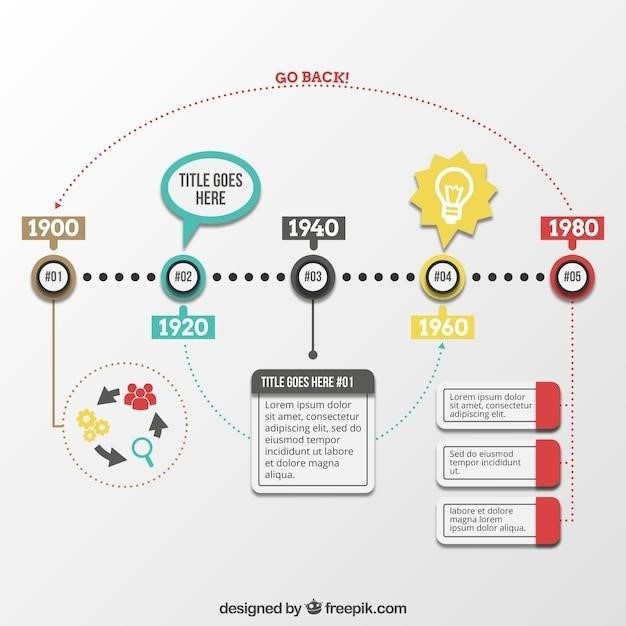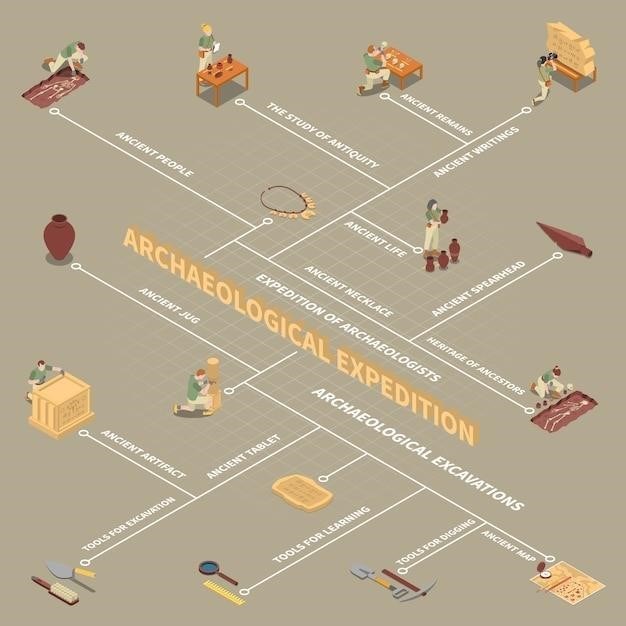Art History Timeline PDF⁚ A Comprehensive Guide

This comprehensive guide provides a chronological overview of major art periods and movements, from prehistoric art to modern art. It includes key artists, their major works, characteristics of each period, and historical events that influenced artistic developments.
Prehistoric Art
Prehistoric art encompasses a vast array of artistic expressions created by early humans before the invention of writing, spanning from the Paleolithic period (c. 30,000 BCE) to the dawn of civilization (c. 3000 BCE). This era witnessed the emergence of remarkable cave paintings, rock carvings, and portable art objects, offering valuable insights into the beliefs, rituals, and daily lives of our ancestors. Cave paintings, such as those found in Lascaux, France, depict animals, humans, and abstract symbols, showcasing the artistic mastery and symbolic thinking of early humans. These paintings are often found deep within caves, suggesting a ritualistic or spiritual purpose. In addition to cave paintings, prehistoric art included rock carvings, also known as petroglyphs, which were created by scratching or pecking into rock surfaces. These carvings often depict animals, hunting scenes, and abstract patterns, reflecting the importance of hunting and the natural world in early human societies. Portable art objects, such as figurines and tools, were crafted from various materials, including bone, ivory, stone, and clay. These objects often served as decorative items, tools, or ritualistic objects. Prehistoric art is characterized by its simplicity, naturalism, and symbolic language, reflecting the early human desire to understand and express their world through artistic means. It provides a window into the creative spirit and intellectual capacity of our ancestors, revealing their deep connection to nature, their belief systems, and their ability to communicate through visual symbols.
Ancient Egypt
Ancient Egyptian art, spanning over 3,000 years from the Predynastic Period (c. 6000 BCE) to the Ptolemaic Period (c. 30 BCE), is renowned for its grandeur, symbolism, and enduring legacy. This art form was deeply intertwined with Egyptian religion and belief in the afterlife, with a strong emphasis on preserving the pharaohs and important figures for eternity. The iconic pyramids, towering monuments built as tombs for pharaohs, are a testament to the Egyptians’ architectural prowess and their belief in the afterlife. The interiors of these tombs were adorned with elaborate murals and hieroglyphic inscriptions, depicting scenes of daily life, religious rituals, and the pharaoh’s journey to the afterlife. Egyptian art is characterized by its distinctive style, featuring idealized human forms, stylized animals, and a strict adherence to proportions and symmetry. The Egyptians developed a sophisticated system of hieroglyphic writing, which was used to record history, literature, and religious texts, further enriching their artistic legacy. Sculptures, ranging from colossal statues of pharaohs to smaller figures of deities and everyday people, were crafted in stone, wood, and bronze. These sculptures were often placed in temples, tombs, and public spaces, serving both as expressions of power and as representations of the divine. The vibrant colors and intricate details of Egyptian paintings, often found on tomb walls and sarcophagi, showcased the Egyptians’ mastery of pigments and techniques. These paintings depicted scenes from mythology, daily life, and the afterlife, providing valuable insights into Egyptian culture and beliefs. Ancient Egyptian art offers a unique glimpse into a civilization that flourished for millennia, leaving behind a rich legacy of artistic achievements that continue to inspire and fascinate us today.
Ancient Greece
Ancient Greek art, flourishing from the Geometric Period (c. 900 BCE) to the Roman conquest (c. 146 BCE), is celebrated for its beauty, idealism, and profound influence on Western art. It encompassed a wide range of mediums, including sculpture, painting, architecture, and pottery, each reflecting the evolving cultural and philosophical values of the time. Greek sculpture, renowned for its realistic portrayal of the human form, epitomized the ideal of beauty and perfection. From the archaic period’s stiff, stylized figures to the classical period’s harmonious and lifelike representations, Greek sculptors strived to capture the essence of human anatomy and motion. Famous examples include the Venus de Milo and the Doryphoros, which embody the classical ideal of balanced proportions and graceful poses. Greek painting, primarily found on pottery and murals, often depicted scenes from mythology, everyday life, and athletic competitions. The use of black-figure and red-figure techniques on pottery allowed artists to create detailed and expressive images. Greek architecture is characterized by its elegant use of columns, arches, and intricate details, exemplified by the Parthenon in Athens. The harmonious proportions and sophisticated construction techniques of Greek temples and other structures continue to inspire architects today. Greek art played a pivotal role in shaping Western aesthetic ideals, influencing later artistic movements and inspiring generations of artists. The enduring legacy of Greek art lies in its ability to transcend time and cultures, captivating viewers with its beauty, skill, and timeless themes.
Ancient Rome
Ancient Roman art, spanning from the 8th century BCE to the 5th century CE, is a fascinating blend of Greek influences and Roman innovation. While Roman art drew heavily from Greek models, it developed its own distinct style, characterized by realism, grandeur, and a focus on practical functionality. Roman sculpture, while often inspired by Greek forms, prioritized realism over idealism. Roman portrait busts, for example, captured the individual features and personalities of their subjects with remarkable accuracy. The Colosseum, a massive amphitheater built in the 1st century CE, stands as a testament to Roman architectural prowess. Its colossal scale, intricate design, and ingenious engineering showcase the Romans’ mastery of construction. Roman painting, primarily found on murals and mosaics, often depicted scenes from mythology, history, and daily life. The Pompeian frescoes, preserved by the eruption of Mount Vesuvius in 79 CE, provide a vivid glimpse into Roman domestic life and artistic techniques. Roman art served not only as a means of artistic expression but also as a powerful tool for propaganda and social control. Monumental sculptures, elaborate mosaics, and grand architecture were used to celebrate Roman victories, commemorate emperors, and project an image of imperial power. The influence of Roman art extended far beyond its geographical boundaries, impacting the development of art throughout Europe and beyond. Roman architectural principles, for example, continued to inspire architects for centuries, while Roman portraiture set a precedent for realistic representation in Western art.
Medieval Art
Medieval art, spanning roughly from the 5th to the 15th centuries, was deeply influenced by the Christian faith and the rise of powerful institutions like the Catholic Church. This era witnessed a shift from the classical styles of antiquity to a more symbolic and spiritual approach to art. One of the defining characteristics of Medieval art is its emphasis on religious themes. Paintings, sculptures, and architectural decorations often depicted biblical stories, saints, and religious figures, serving as visual aids for a largely illiterate population. The Byzantine Empire, with its capital in Constantinople, played a significant role in shaping Medieval art. Byzantine art is characterized by its stylized figures, flat perspective, and rich use of gold and mosaics. The Hagia Sophia, a magnificent cathedral built in Constantinople in the 6th century, exemplifies Byzantine architecture with its soaring domes, intricate mosaics, and grandeur. In Western Europe, the Romanesque and Gothic styles emerged as dominant architectural trends. Romanesque architecture, characterized by its heavy, rounded arches, thick walls, and small windows, was exemplified by cathedrals such as the Abbey Church of Cluny in France. Gothic architecture, with its pointed arches, soaring vaults, and stained glass windows, reached its zenith in cathedrals like Notre Dame in Paris. Medieval art was not merely decorative but also served as a tool for religious instruction, social commentary, and political propaganda. Religious imagery was used to convey theological doctrines, while secular art reflected the social and political realities of the time. The art of the Middle Ages laid the foundation for the artistic revolutions that would follow, particularly the Renaissance, which drew inspiration from both Classical and Medieval traditions.
Renaissance
The Renaissance, a period of immense cultural and artistic rebirth in Europe, spanned roughly from the 14th to the 16th centuries. This era witnessed a renewed interest in classical art, literature, and philosophy after the Middle Ages. The Renaissance marked a shift from the medieval focus on religious themes to a renewed appreciation for humanism, naturalism, and individual expression. Artists like Leonardo da Vinci, Michelangelo, and Raphael emerged as giants of the Renaissance, pushing the boundaries of artistic innovation. Leonardo da Vinci, a true polymath, embodied the Renaissance ideal of the “universal man.” His masterpieces, including the Mona Lisa and The Last Supper, showcased his mastery of anatomy, perspective, and sfumato, a technique that creates a soft, hazy effect. Michelangelo, renowned for his sculptures and paintings, embodied the Renaissance spirit of grandeur and power. His David, a monumental marble sculpture, epitomizes the ideal of the human form, while his frescoes on the Sistine Chapel ceiling are a testament to his unparalleled artistic genius. Raphael, known for his harmonious compositions and elegant figures, produced iconic works like The School of Athens and Madonnas. The Renaissance saw a resurgence in the study of classical art and architecture, leading to a revival of classical styles. The architectural masterpieces of the era, such as the Basilica of St. Peter’s in Rome and the Palazzo Vecchio in Florence, showcased the elegance and grandeur of classical forms. The Renaissance was not just about art but also about scientific advancements, philosophical inquiry, and a rediscovery of the human potential. This period laid the foundation for the scientific revolution and the Enlightenment, marking a pivotal moment in Western history. The legacy of the Renaissance continues to inspire artists and thinkers today, reminding us of the power of human creativity and the enduring beauty of classical ideals.
Baroque
The Baroque era, spanning roughly from the early 17th century to the late 18th century, marked a departure from the Renaissance’s emphasis on harmony and balance. This period was characterized by a dramatic, theatrical style that emphasized movement, emotion, and grandeur. Baroque art celebrated the power of the Catholic Church and the grandeur of the monarchies of Europe. The era witnessed a flourishing of architectural masterpieces, such as St. Peter’s Basilica in Rome, designed by Gian Lorenzo Bernini, and the Palace of Versailles in France, a testament to the opulence of the French monarchy. Baroque painting was characterized by dramatic contrasts of light and shadow, known as chiaroscuro, creating a sense of depth and intensity. Artists like Caravaggio, Rembrandt, and Rubens masterfully employed this technique, capturing a sense of realism and emotion in their works. Caravaggio’s dramatic use of light and shadow, often depicting biblical scenes with realistic detail, revolutionized painting. Rembrandt, known for his masterful use of light and his psychological portraits, painted iconic works like The Night Watch, a masterpiece of Baroque artistry. Rubens, a prolific painter, celebrated the human form with his dynamic compositions and vibrant colors, capturing the spirit of the Baroque era. Baroque sculpture, like Baroque painting, emphasized drama, movement, and emotion. Bernini, a master sculptor, created works like the Ecstasy of Saint Teresa, a masterpiece that embodies the theatricality and emotion of the Baroque style. The Baroque era was a period of intense religious fervor, political power, and artistic expression. It marked a shift from the Renaissance’s classical ideals to a more dramatic and expressive style, leaving an enduring legacy on Western art and culture.
Rococo
Following the grandeur and drama of the Baroque era, the Rococo style emerged in the early 18th century, characterized by a lighter, more playful, and decorative aesthetic. This period embraced elegance, grace, and a sense of frivolity, reflecting the aristocratic lifestyle of the French court. Rococo art celebrated love, pleasure, and the beauty of nature, often depicting scenes of courtship, idyllic landscapes, and intimate gatherings. The Rococo style found expression in a wide range of artistic mediums, from painting and sculpture to architecture and interior design. Rococo painting, known for its delicate pastel colors, graceful curves, and whimsical subject matter, was often characterized by a sense of lightness and elegance. Artists like Jean-Antoine Watteau, François Boucher, and Jean-Honoré Fragonard captured the essence of Rococo in their paintings, depicting scenes of love, music, and leisure. Watteau’s paintings, known for their ethereal beauty and melancholy charm, captured the spirit of the Rococo era, portraying the fleeting pleasures of life. Boucher’s paintings, often characterized by their playful sensuality and decorative motifs, reflected the Rococo aesthetic of elegance and refinement. Fragonard’s paintings, known for their vibrant colors and sensual subject matter, embodied the Rococo spirit of playful love and seduction. Rococo sculpture, like Rococo painting, emphasized elegance, grace, and a sense of playfulness. Sculptors like Jean-Baptiste Pigalle and Clodion created works that reflected the Rococo aesthetic, often depicting mythological figures and scenes of love and beauty. Rococo architecture, characterized by its ornate details, graceful curves, and playful use of space, reflected the era’s emphasis on elegance and refinement. The Rococo style, with its emphasis on beauty, pleasure, and refinement, had a profound impact on art and design, shaping the visual landscape of the 18th century.

Neoclassicism
Emerging as a reaction against the Rococo’s excesses and frivolity, Neoclassicism arose in the late 18th century, drawing inspiration from the art and architecture of ancient Greece and Rome. This movement emphasized reason, order, and a return to classical ideals of beauty and simplicity, reflecting the Enlightenment’s intellectual and philosophical currents. Neoclassical art sought to convey a sense of clarity, balance, and restraint, emphasizing the importance of line, form, and composition. Artists like Jacques-Louis David, Jean-Auguste-Dominique Ingres, and Antonio Canova championed the Neoclassical style, producing works that celebrated the ideals of virtue, patriotism, and heroism. David’s paintings, known for their precise detail, dramatic compositions, and patriotic themes, exemplified the Neoclassical spirit. His iconic work, “The Oath of the Horatii,” depicted a scene of heroic sacrifice and civic duty, reflecting the movement’s emphasis on civic virtue and patriotism. Ingres’s paintings, characterized by their sharp lines, precise details, and idealized figures, further embodied the Neoclassical aesthetic. His works often portrayed classical subjects, such as mythological figures and scenes from ancient history, highlighting the movement’s fascination with classical antiquity. Canova’s sculptures, renowned for their idealized beauty and masterful technique, embodied the Neoclassical ideal of perfect form. His sculptures, often depicting classical figures and themes, reflected the movement’s admiration for the artistic achievements of ancient Greece and Rome. Neoclassical architecture, inspired by the architectural principles of ancient Greece and Rome, emphasized order, symmetry, and simplicity. Buildings like the Pantheon in Paris and the United States Capitol Building in Washington, D.C., exemplify the Neoclassical style, showcasing its enduring influence on architecture.
